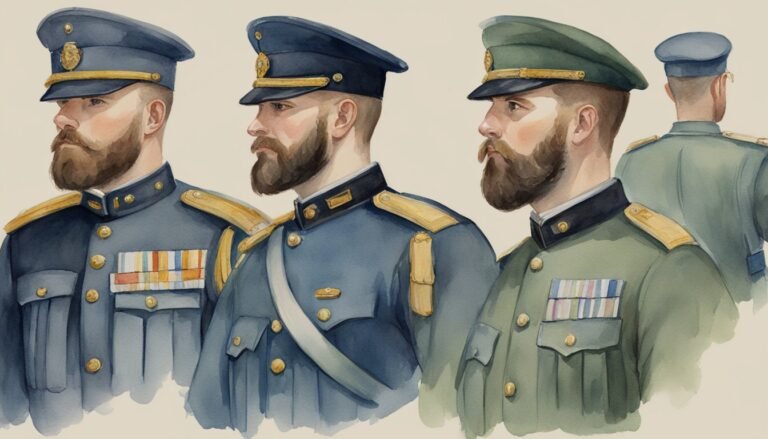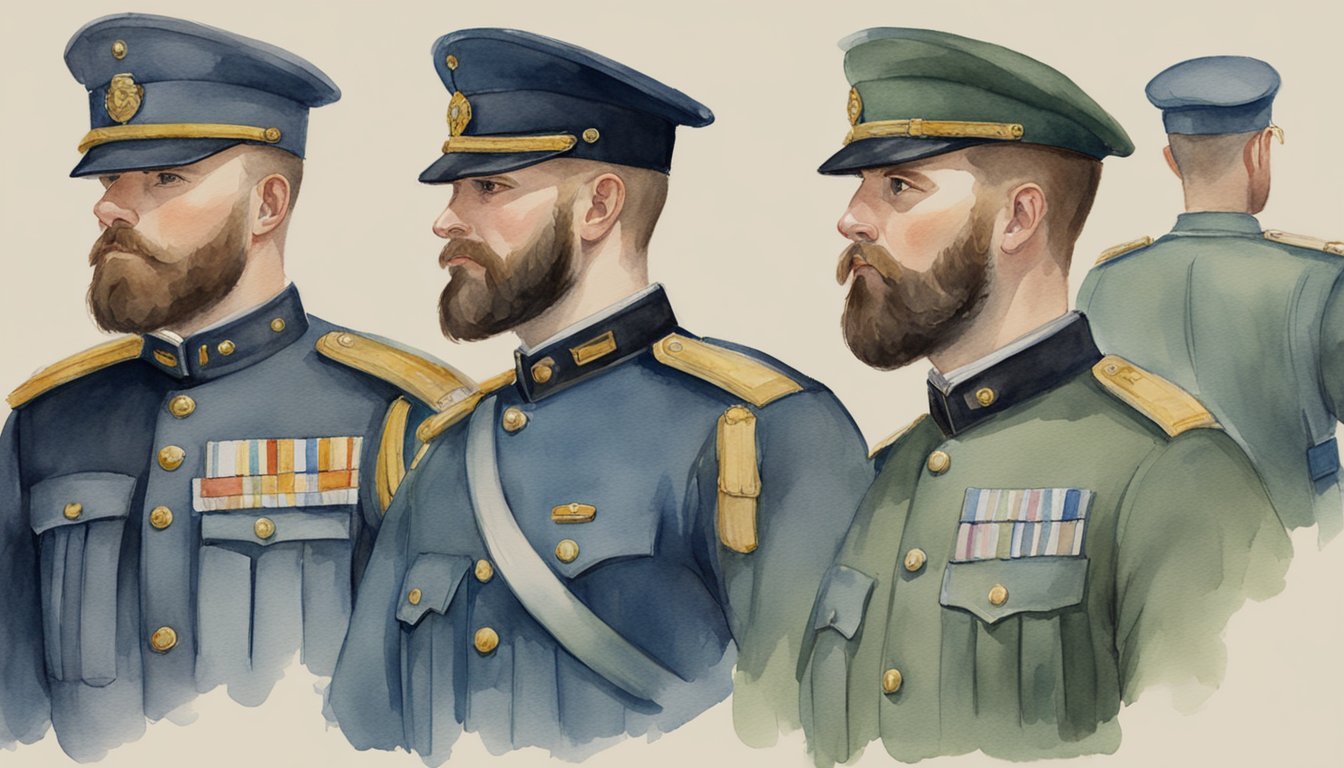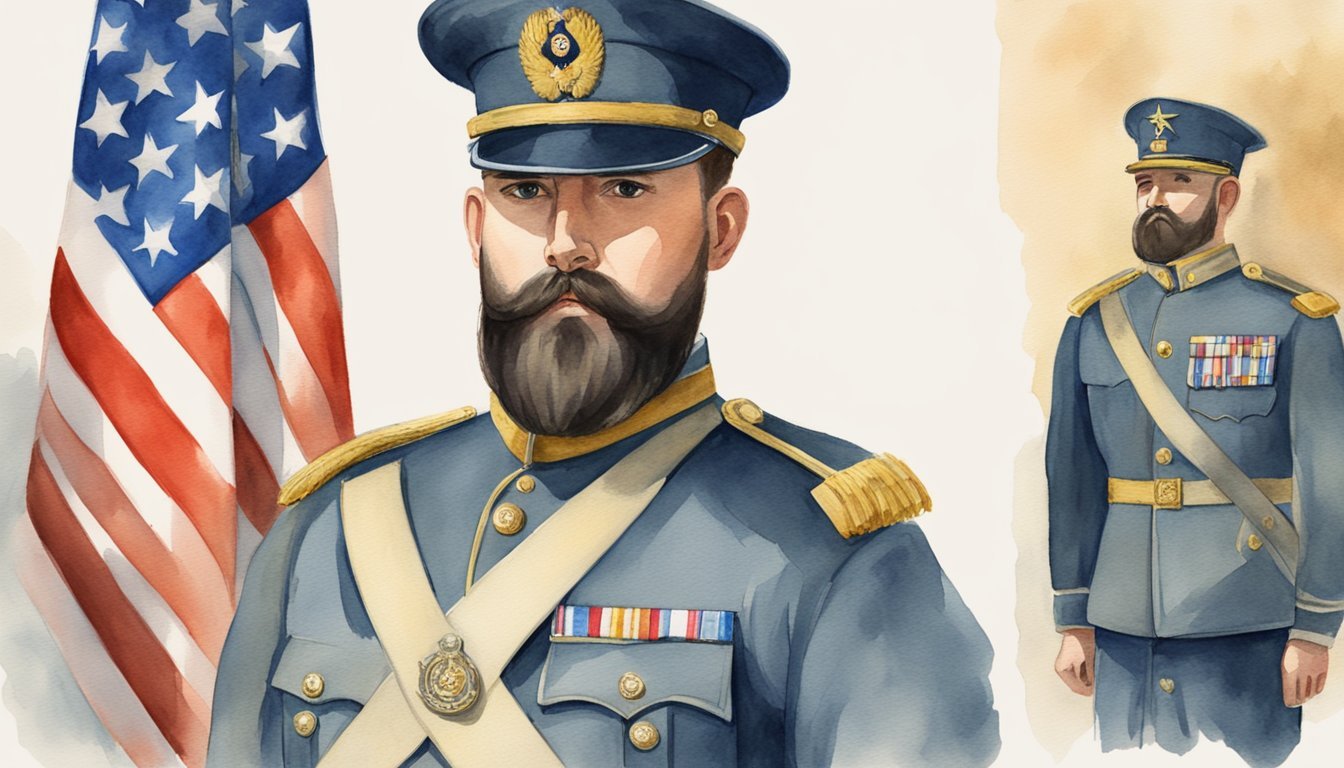Army Regulations AR 670 1 Beard Regulations: What You Need to Know

Growing a beard might be popular in civilian life, but the rules are different when it comes to military service.
If you’re in the U.S. Army, you need to be aware of the regulations that govern your appearance. According to AR 670-1, beards are not permitted for male soldiers, whether in uniform or on duty in civilian clothes.
This policy ensures a uniform look and promotes discipline and professionalism among soldiers.

These regulations also cover other aspects of grooming, such as the allowance of mustaches.
It’s essential to keep yourself informed about these guidelines to avoid any potential disciplinary actions.
Understanding the specifics can help you maintain the high standards expected of members of the U.S. Army.
In addition to maintaining a clean-shaven appearance, soldiers are expected to adhere to other grooming standards to exhibit the highest level of professionalism and commitment.
Staying updated with the current policies, including any changes to AR 670-1, is crucial for every soldier.
Key Takeaways
- Beards are not allowed for male soldiers in the U.S. Army.
- Mustaches are permitted under specific guidelines.
- Adhering to grooming standards reflects professionalism and discipline.
Historical Background of AR 670-1
Army Regulation 670-1, also known as AR 670-1, has a long history dating back to its first establishment.
This regulation sets the standards for the wear and appearance of Army uniforms and insignia.
It aims to promote professionalism and uniformity among soldiers.
In the early 20th century, the Army began formalizing these regulations.
Over the years, AR 670-1 has been updated to reflect changes in military standards and society.
Each change ensures that soldiers present a professional appearance while in uniform.
Starting from the 1970s, AR 670-1 has undergone numerous revisions.
Policies have been updated to include specific guidelines on grooming, such as hair length and facial hair.
One significant update involved guidelines for professional grooming and limiting the types of acceptable hairstyles for both men and women.
In recent years, the Army has focused on diversity and inclusion.
This has led to more flexible grooming standards, such as the inclusion of certain religious accommodations.
One notable change involved the allowance for “beards” in specific cases, like for religious reasons.
AR 670-1 has continued to balance historical traditions with modern needs.
The changes ensure that the Army can maintain a disciplined and professional force while also respecting individual differences.
Through these updates, Uniform Policy has adapted to the evolving needs of the Army.
The goal remains to ensure that all soldiers represent the Army’s values and traditions in their appearance.
General Appearance and Grooming Principles
Adhering to grooming and appearance standards in the military is crucial for maintaining a professional image.
These principles ensure that everyone looks neat, tidy, and ready for duty.
Professional Standards of Appearance
In the military, looking professional is a top priority.
You are expected to maintain a tidy and neat appearance at all times.
Your uniform should be clean and well-fitted, emphasizing a sharp and disciplined look. Uniforms should be free of wrinkles, and all insignia must be properly placed and polished.
It’s also important that your personal hygiene is up to standard.
Regular showers, clean nails, and good oral hygiene are essential to uphold the military’s professional image.
Shoes should be shined regularly, and any worn-out uniform parts should be replaced immediately.
These standards ensure that you project a professional and reliable image, making it easier to gain respect and trust within your unit.
Grooming Standards for Men and Women
Men must keep their hair short and neat.
It should not touch the ears or collar, creating a tapered appearance.
Mustaches are allowed, but they must be kept trimmed and should not extend below the edge of the upper lip or past the corners of the mouth.
Beards are generally not permitted unless for medical or religious reasons.
For women, hair should be styled to ensure it does not fall below the collar.
If your hair is longer, it should be neatly tied up or in a bun.
Makeup and nail polish, if worn, need to be subtle and in natural colors.
Both men and women must ensure their appearance aligns with safety standards, especially in field operations, where loose hair can be a hazard.
Following these grooming standards helps maintain uniformity and projection of strength.
Hair Regulations and Authorized Styles
In the military, maintaining a professional appearance is crucial.
Specific guidelines outline how soldiers should wear their hair to ensure uniformity and discipline.
Hairstyles for Male Soldiers
For male soldiers, hair must be neatly groomed and present a neat appearance.
Hair can be bulky but should have a tapered look from the top of the head to the neck.
No portion of the hair should extend over the ears, eyebrows, or collar.
Tiny hairs on the back of the neck are exceptions.
Male soldiers are not allowed to have Mohawks.
Haircuts like high and tight, crew cuts, and flat tops are common.
These styles are practical and meet Army regulations.
The goal is to balance personal preference with the need for a disciplined look.
Hairstyles for Female Soldiers
Female soldiers have more flexibility but still must adhere to specific guidelines.
Hair can be worn short, medium, or long, provided it looks neat and does not interfere with wearing headgear.
Long hair must be tied in a bun or ponytail that does not exceed three and a half inches in bulk.
When combed, hair must not fall over eyebrows or touch the collar.
Multiple hairstyles are allowed, including braids and twists, as long as they are well-maintained.
All styles should promote a professional appearance while enabling you to perform your duties effectively.
Beard, Mustache, and Facial Hair Guidelines
Military grooming standards are strict.
You need to know the specific rules for beards, mustaches, and other facial hair to maintain a neat appearance and comply with regulations.
Beard Policy for Male Soldiers
Male soldiers are generally not allowed to grow beards.
However, there are exceptions for religious accommodation or medical reasons.
If you get permission for a beard under these conditions, it needs to be well-maintained.
Beards must not exceed 2 inches in length when measured from the bottom of your chin.
You need to ensure the beard is neatly trimmed at all times to maintain a professional look.
Beards should not give a bushy appearance and must be evenly trimmed.
Mustache and Facial Hair Regulations
The Army allows mustaches, but they must be neat and well-groomed.
Your mustache should not cover the upper lip line or extend sideways beyond a vertical line from the corners of your mouth.
Other facial hair like sideburns must also comply with set standards.
Sideburns cannot extend below the bottom of the ear opening and must be neatly trimmed.
You can’t have unusual styles like Mohawks or others that attract attention.
For more detailed information, refer to AR 670-1 Mustache Regulation.
Uniform Wear and Insignia

Understanding the wear and appearance of Army uniforms is essential for maintaining professionalism and discipline.
This section covers the key aspects of the Army Green Service Uniform, Army Combat Uniform, and dress uniforms and their accessories.
Army Green Service Uniform
The Army Green Service Uniform (AGSU) is a traditional, semi-formal uniform used by personnel.
It includes an olive-drab coat and trousers, a dark brown tie, and a khaki shirt.
The shoulder sleeve insignia is worn to identify the unit of assignment.
Headgear options include the olive-drab service cap or a beret.
For footwear, brown leather shoes are standard.
Ensure your insignia is correctly placed on collars and shoulders.
The AGSU helps present a sharp, cohesive appearance in many formal settings, reflecting Army values and heritage.
Army Combat Uniform (ACU)
The Army Combat Uniform (ACU) is designed for durability and functionality.
It uses the Operational Camouflage Pattern (OCP), which blends with various environments.
The uniform includes a helmet, combat boots, and a moisture-wicking t-shirt.
The sleeves have Velcro patches for attaching the American flag and unit insignia.
Standard duty gear includes protective vests, knee and elbow pads, and cargo pockets for carrying equipment.
This uniform is worn in operational settings and exercises, ensuring soldiers are equipped for combat scenarios.
Remember, neatness and proper placement of insignia are critical for maintaining a professional look.
Dress Uniforms and Accessories
Dress uniforms are used for formal occasions, ceremonies, and official functions.
They include the Army Service Uniform (ASU), which features a midnight blue coat, trousers, and a white shirt.
Accessories like medals, ribbons, and badges are worn to display achievements and rank.
Headgear options include garrison caps or berets, depending on the event.
Officers may also wear dress swords during particular ceremonies.
Watches and sunglasses should be conservative and not distract from the overall appearance.
Properly maintained dress uniforms reflect honor and respect for Army traditions.
Make sure your badges and medals are correctly aligned and polished.
This attention to detail ensures you look your best during important events.
Grooming Personal Items
Adhering to grooming standards is crucial for maintaining discipline and uniformity in the Army.
This section covers rules on earrings, eyeglasses, and nail regulations, plus guidelines on tattoos and body modifications.
Earrings, Eyeglasses, and Contact Lenses
Male soldiers are not allowed to wear earrings while in uniform.
Female soldiers can wear earrings with the Army Combat Uniform (ACU), but they must be gold, silver, or diamond studs not exceeding 6 mm in size.
Eyeglasses should be conservative in design.
Avoid bright colors or large, flashy frames.
If you wear contact lenses, ensure they provide a natural eye color. Colored contacts that enhance, contrast, or change the eye’s natural color are not permitted.
Having proper eyewear is necessary for practical reasons and maintains a professional appearance that the Army values.
Nail Regulations
Nail grooming policies are equally strict.
Male soldiers must keep their nails trimmed and clean, extending no more than a few millimeters beyond the fingertip.
Female soldiers have a bit more flexibility but must ensure their nails do not exceed 1/4 inch from the tip of the finger.
Nail polish for female soldiers should be clear or a shade that complements the skin tone, such as beige or nude. Bright or trendy colors are not allowed.
Clear nail polish is also permissible for females, offering a basic, neat appearance.
Taking care of your nails ensures that you meet hygiene standards and maintain the disciplined look required in the Army.
Tattoo and Body Modification Guidelines
Tattoo regulations are detailed to ensure that soldiers present a uniform and professional image. Tattoos below the wrist are prohibited, as are those on the face, neck, and hands, with the exception of one ring tattoo per hand.
Sexist, extremist, or vulgar tattoos are strictly barred.
Regarding body modifications, body piercings other than earrings for females are not allowed while in uniform.
This includes visible tongue or lip piercings.
These guidelines help promote a professional environment and are part of upholding the Army’s values and standards.
For more information, you can check the PDF on Uniform and Insignia Wear or the Facial Hair Standards.
Diversity, Equity, and Inclusion Efforts
Recent changes in Army regulations reflect significant efforts to promote diversity, equity, and inclusion.
These efforts extend to grooming standards, religious accommodations, and fostering a culture where everyone can thrive.
Cultural and Religious Accommodations
The Army has made important changes to allow for various cultural and religious practices.
For example, soldiers can now wear hijabs and turbans as part of their uniform.
This is a big step forward in recognizing the diverse backgrounds of Army personnel.
Also, accommodations for beards are permitted for religious reasons.
This helps Muslim, Sikh, and other soldiers maintain their faith practices.
These changes aim to create a welcoming environment for all service members, reflecting the Army’s commitment to diversity and inclusion.
Efforts Towards Inclusivity
Inclusivity in the Army goes beyond uniforms and grooming standards.
The “People First” initiative prioritizes the well-being of all soldiers.
Training programs now emphasize equity and empathy, so everyone feels respected and included.
Diverse representation is also encouraged in leadership roles.
By doing this, the Army ensures that decision-makers better reflect the diverse makeup of the force.
These efforts aim to build a cohesive and respectful environment, benefiting not just the soldiers, but also the mission’s success.
By incorporating these changes, the Army shows it values each member’s cultural and personal identity.
This approach helps maintain a strong, united, and effective military force.
Special Circumstances
In some situations, the Army allows certain exceptions to the beard regulations detailed in AR 670-1.
These exceptions usually involve medical conditions and specific guidelines related to breastfeeding while on duty.
Accommodations for Medical Conditions
If you have a medical condition that makes shaving problematic, you can apply for a medical exemption.
Conditions like pseudofolliculitis barbae (PFB), a skin condition caused by shaving, qualify for this exemption.
You need a valid diagnosis from a medical professional.
Once approved, you may keep a neatly trimmed beard.
It should not affect the proper fit or seal of a gas mask.
It’s essential to follow the guidelines to ensure your beard is within the allowed length and appearance standards.
To apply, submit your medical documentation to your unit commander.
The commander will review the submission and can grant the exemption if all requirements are met.
Guidelines on Breastfeeding and Duty
Breastfeeding mothers have special considerations under Army regulations.
While beards are generally not part of this topic, accommodations related to duty schedules and uniform adjustments are relevant.
You are entitled to reasonable breaks to pump or breastfeed.
Your duty schedule may be adjusted to accommodate these breaks.
The Army provides designated lactation areas to ensure privacy and comfort.
Additionally, uniform modifications may be necessary.
You should discuss any needed changes to your uniform with your chain of command.
These modifications should align with Army standards while providing the necessary accommodations.
Each accommodation aims to support you without compromising mission readiness or uniformity.
Always keep an open line of communication with your superiors to ensure your needs are met within the regulations.
AR 670-1 Updates and Future Trends
Recent changes to AR 670-1 focus on improving uniform and grooming standards.
The updates from ALARACT 40/2021 include new grooming standards that aim to reflect the diverse nature of the U.S. Army.
You’ll notice some important changes:
- Minimum hair length: Soldiers now have more flexibility with hair length, as the new policy allows for shorter hair as long as it meets the required professional appearance.
- Multiple hairstyles: There are now more approved hairstyles for all soldiers, aiming to be inclusive and adapting to various hair textures and types.
LT. Gen. Gary Brito has been a key advocate for these changes, working to ensure that the new grooming standards support both practicality and inclusiveness.
The goal is to maintain a professional appearance while also considering the needs of soldiers from diverse backgrounds.
The U.S. Army Appearance and Grooming Modifications have sparked discussions about future trends.
For example:
- Potential beard allowances for soldiers, particularly for religious or medical reasons.
- Further customization of uniforms to better serve different body types and needs.
These trends indicate a move towards a more personalized and accommodating approach, reflecting the evolving nature of military service.
The ongoing updates aim to strike a balance between maintaining discipline and being inclusive, recognizing the importance of both.
Keep an eye out for more changes in the future as the Army continues to adapt.
Adherence and Accountability
In the Army, adherence to beard regulations is crucial for maintaining uniformity and professionalism.
It is enforced through a defined chain of command, with specific consequences for those who fail to comply.
Chain of Command and Enforcement
The chain of command plays a vital role in enforcing AR 670-1 beard regulations.
Officers and non-commissioned officers (NCOs) are responsible for ensuring soldiers meet grooming standards.
They conduct regular inspections and provide guidance on acceptable grooming practices.
Grooming standards dictate that male soldiers must keep their faces clean-shaven while in uniform or when in civilian clothes on duty.
Mustaches are allowed, but they must be neatly trimmed and not extend past the corners of the mouth.
No faddish beard styles or offensive language is tolerated.
Violations are reported up the chain of command, where appropriate action is taken.
Consequences of Non-Compliance
Failing to comply with beard regulations can lead to various consequences. Professionalism is a key aspect of military service, and adhering to grooming standards is part of that.
Soldiers who do not follow these rules may face counseling or reprimand from their superiors.
Repeated offenses can result in more severe actions, such as non-judicial punishment under the Uniform Code of Military Justice (UCMJ).
In civilian clothes, the same standards apply if on duty, reinforcing the idea that adherence is ongoing regardless of attire.
The penalties are in place to ensure uniformity, discipline, and the overall integrity of the Army, reminding soldiers of their commitment to military values.
Frequently Asked Questions
In this section, you’ll find answers to common questions about the Army’s beard regulations.
The information here can help you understand the rules and any possible exceptions that might apply.
What’s the latest update on beard policies in the Army?
Beards are not allowed for soldiers in the Army.
The Army’s grooming standards, outlined in AR 670-1, require male soldiers to keep their faces clean-shaven when in uniform or on duty in civilian clothes.
Mustaches are permitted under certain guidelines.
How does one qualify for a shaving profile in the Army?
You can qualify for a shaving profile if you have a medical condition that prevents you from shaving regularly.
A healthcare provider must diagnose this condition, and then you will receive a shaving profile that allows for trimmed facial hair.
Can you give me the rundown on facial hair rules according to AR 670-1?
According to AR 670-1, male soldiers must keep their faces clean-shaven.
Beards are not permitted, except for medical reasons.
Mustaches are allowed but must be neatly trimmed and not extend beyond the corners of the mouth.
Are mustaches allowed in the Army, and if so, what are the guidelines?
Yes, mustaches are allowed.
They must be neatly trimmed and not extend beyond the corners of the mouth.
The mustache should not cover the upper lip or reach beyond the edges of the mouth.
How can an Army officer apply for a beard waiver?
To apply for a beard waiver, an Army officer needs to have a medical condition diagnosed by a healthcare provider.
After receiving the diagnosis, the officer will be granted a shaving profile that permits trimmed facial hair.
Are there any changes to AR 670-1 regarding facial hair for the year 2024?
As of now, there are no significant changes to AR 670-1 regarding facial hair for 2024.
The rules still require male soldiers to be clean-shaven, with allowances for medical shaving profiles and neatly trimmed mustaches.
For the latest updates, you can check the Army’s official beard regulations page.






